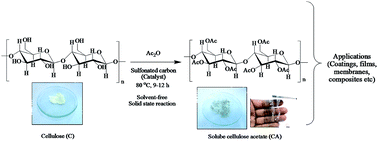Sulfonated carbon as a new, reusable heterogeneous catalyst for one-pot synthesis of acetone soluble cellulose acetate†
Abstract
A sulfonated carbon (SO3H/PhSO3H-carbon) catalyzed novel process was developed for the solvent free synthesis of acetone soluble-cellulose acetate (CA) via acetylation of cellulose with acetic anhydride. The SO3H/PhSO3H functionalized carbons easily outperformed the traditional solid acids (zeolites, heteropoly acids, Amberlyst-15 etc.) producing acetylated products with DS values between 1.6 and 2.94, in high yield (48–77% isolated yield) and under solvent free conditions, in a one-pot process. Further, it was possible to produce the commercially desired, soluble CA (DS values 2–2.7) in excellent yields (∼70%) from microcrystalline cellulose under optimized reaction conditions over the highly active mesoporous sulfonated catalyst (AC500S). A catalyst-to-cellulose (w/w) ratio of 1, acetic anhydride-to-AGU (anhydroglucose unit) mole ratio of 4.5 and reaction time of 12 h was applied. Additionally, the sulfonated catalyst could be easily recovered by centrifugal separation of the reaction mixture (diluted with acetone) and subsequently applied in the next reaction cycle with no significant reduction in yield and DS of CA over multiple reaction cycles.


 Please wait while we load your content...
Please wait while we load your content...